沙特阿美公司钻修井工艺流程简介--李艳民教材
- 格式:ppt
- 大小:785.50 KB
- 文档页数:37
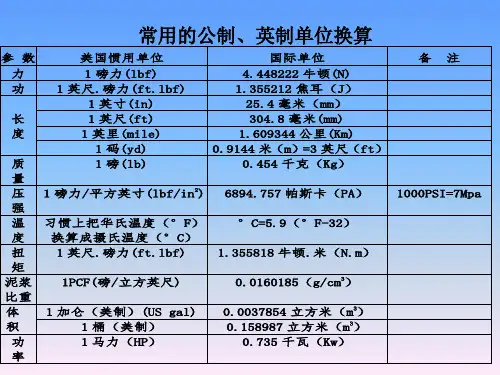
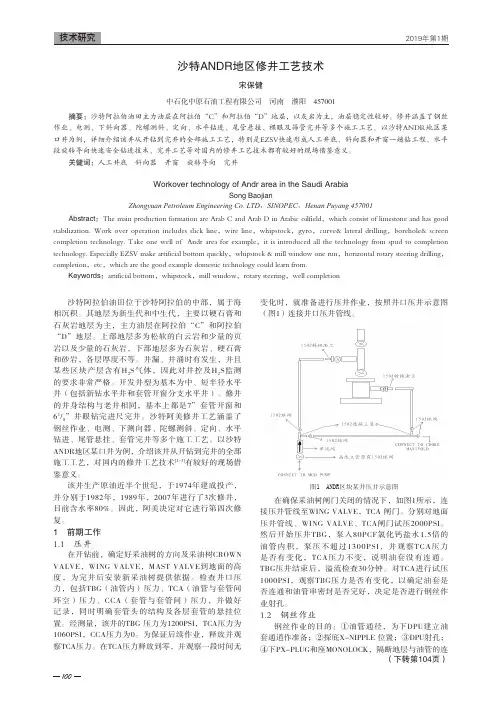
100沙特阿拉伯油田位于沙特阿拉伯的中部,属于海相沉积。
其地层为新生代和中生代,主要以硬石膏和石灰岩地层为主,主力油层在阿拉伯“C”和阿拉伯“D”地层。
上部地层多为松软的白云岩和少量的页岩以及少量的石灰岩,下部地层多为石灰岩、硬石膏和砂岩,各层厚度不等。
井漏、井涌时有发生,并且某些区块产层含有H 2S气体,因此对井控及H 2S监测的要求非常严格。
开发井型为基本为中、短半径水平井(包括新钻水平井和套管开窗分支水平井)。
修井的井身结构与老井相同,基本上都是7”套管开窗和61/8”井眼钻完进尺完井。
沙特阿美修井工艺涵盖了钢丝作业、电测、下测向器、陀螺测斜、定向、水平钻进、尾管悬挂、套管完井等多个施工工艺。
以沙特ANDR地区某口井为例,介绍该井从开钻到完井的全部施工工艺,对国内的修井工艺技术[1-3]有较好的现场借鉴意义。
该井生产原油近半个世纪,于1974年建成投产,并分别于1982年,1989年,2007年进行了3次修井,目前含水率80%。
因此,阿美决定对它进行第四次修复。
1 前期工作1.1 压井在开钻前,确定好采油树的方向及采油树CROWN VALVE,WING VALVE,MAST VALVE到地面的高度,为完井后安装新采油树提供依据。
检查井口压力,包括TBG(油管内)压力、TCA(油管与套管间环空)压力、CCA(套管与套管间)压力,并做好记录,同时明确套管头的结构及各层套管的悬挂位置。
经测量,该井的TBG 压力为1200PSI,TCA压力为1060PSI,CCA压力为0。
为保证后续作业,释放并观察TCA压力。
在TCA压力释放到零,并观察一段时间无变化时,就准备进行压井作业,按照井口压井示意图(图1)连接井口压井管线。
图1 ANDR区块某井压井示意图在确保采油树闸门关闭的情况下,如图1所示,连接压井管线至WING VALVE,TCA 闸门。
分别对地面压井管线、WING VALVE、TCA闸门试压2000PSI。
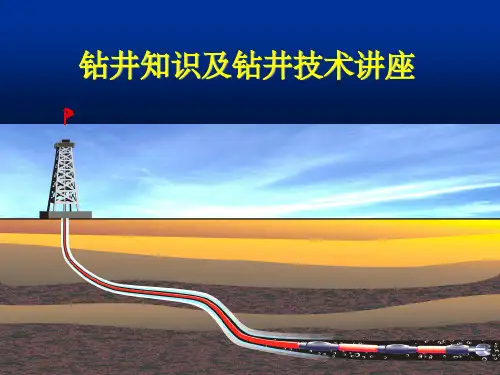

钻井工艺流程一、引言钻井工艺是石油勘探开发的重要环节之一,它是通过钻井设备将钻头钻入地下,获取地下矿藏信息并进行开发的过程。
本文将介绍钻井工艺的流程及其关键步骤,包括井前准备、钻井操作、井下作业和井后处理等内容。
二、井前准备井前准备是钻井工艺流程的第一步,主要包括选址、勘探和设计等工作。
首先,选址是根据地质调查和勘探数据,选择适合进行钻井作业的地点。
然后,进行勘探工作,通过地质勘探手段获取地下矿藏的信息,包括地质构造、岩性、地层厚度等。
最后,根据勘探结果和设计要求,制定钻井方案,包括井深、井眼直径、钻井液类型等。
三、钻井操作钻井操作是钻井工艺流程的核心部分,主要包括井下钻井和井上控制两个方面。
井下钻井是指将钻头通过钻杆系统下放到井口以下,利用旋转和冲击力将钻头钻进地下的过程。
井上控制是指通过控制钻机和钻井液等设备,对井下钻井过程进行监控和调节。
1. 钻杆下放将钻杆下放到井口以下,直至达到设计井深。
钻杆需要具有足够的强度和刚度,以承受井下钻井过程中的冲击力和扭矩。
在钻杆下放过程中,需要注意保持钻杆的垂直度,防止偏斜。
2. 钻头钻井钻头是钻井工艺中的重要工具,它通过旋转和冲击力将地层岩石钻穿。
钻头通常由钻头体和钻嘴组成,钻头体负责传递旋转力和冲击力,钻嘴负责切削和破碎地层岩石。
在钻井过程中,需要根据地层的不同特点选择不同类型的钻头,以提高钻井效率和质量。
3. 钻井液循环钻井液是钻井工艺中的重要介质,它具有冷却钻头、悬浮岩屑、控制井壁稳定等功能。
钻井液循环系统由泥浆池、泥浆泵、钻井管道等组成,通过泵送和循环钻井液,实现岩屑的清除和地层的稳定。
在钻井液循环过程中,需要根据地层的不同特点和钻井要求,调整钻井液的性能参数,包括密度、粘度和过滤性能等。
四、井下作业井下作业是指在钻井过程中进行的其他工作,主要包括取心、测井和固井等。
取心是通过取心工具在井中取得地层样品,用于地质分析和油气含量评估。
测井是通过测井工具对井内的地层进行物理和化学参数的测量,用于地层评价和井壁稳定分析。
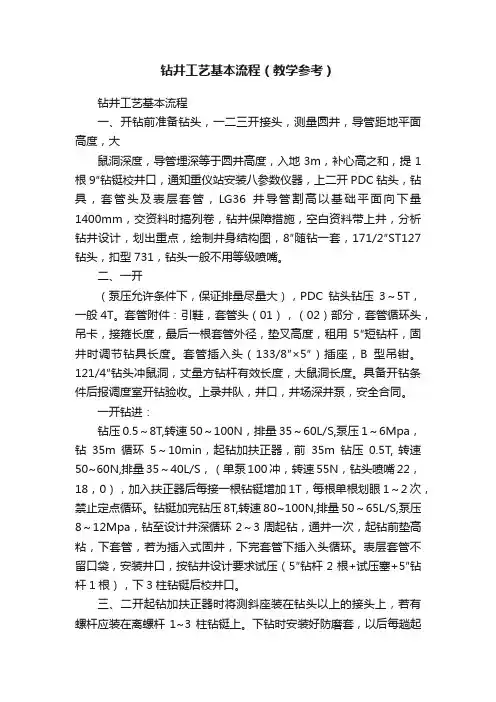
钻井工艺基本流程(教学参考)钻井工艺基本流程一、开钻前准备钻头,一二三开接头,测量圆井,导管距地平面高度,大鼠洞深度,导管埋深等于圆井高度,入地3m,补心高之和,提1根9″钻铤校井口,通知重仪站安装八参数仪器,上二开PDC钻头,钻具,套管头及表层套管,LG36井导管割高以基础平面向下量1400mm,交资料时搞列卷,钻井保障措施,空白资料带上井,分析钻井设计,划出重点,绘制井身结构图,8″随钻一套,171/2″ST127钻头,扣型731,钻头一般不用等级喷嘴。
二、一开(泵压允许条件下,保证排量尽量大),PDC钻头钻压3~5T,一般4T。
套管附件:引鞋,套管头(01),(02)部分,套管循环头,吊卡,接箍长度,最后一根套管外径,垫叉高度,租用5″短钻杆,固井时调节钻具长度。
套管插入头(133/8″×5″)插座,B型吊钳。
121/4″钻头冲鼠洞,丈量方钻杆有效长度,大鼠洞长度。
具备开钻条件后报调度室开钻验收。
上录井队,井口,井场深井泵,安全合同。
一开钻进:钻压0.5~8T,转速50~100N,排量35~60L/S,泵压1~6Mpa,钻35m循环5~10min,起钻加扶正器,前35m钻压0.5T, 转速50~60N,排量35~40L/S,(单泵100冲,转速55N,钻头喷嘴22,18,0),加入扶正器后每接一根钻铤增加1T,每根单根划眼1~2次,禁止定点循环。
钻铤加完钻压8T,转速80~100N,排量50~65L/S,泵压8~12Mpa,钻至设计井深循环2~3周起钻,通井一次,起钻前垫高粘,下套管,若为插入式固井,下完套管下插入头循环。
表层套管不留口袋,安装井口,按钻井设计要求试压(5″钻杆2根+试压塞+5″钻杆1根),下3柱钻铤后校井口。
三、二开起钻加扶正器时将测斜座装在钻头以上的接头上,若有螺杆应装在离螺杆1~3 柱钻铤上。
下钻时安装好防磨套,以后每趟起钻都要松顶丝,第一只钻头121/4″ST127,铣齿,15,12,18;下钻探塞,遇阻不超过5T,探得塞后起1柱,接钻杆套管内试压(按设计要求试压),钻塞不宜太快,钻压0.5~2T, 转速45~50N,钻进地层5~10m 循环1~2周,地破试验,套管鞋以下50m控制钻压2~4T,转速45~55N,排量35~40L/S,每根单根循环10~20min,钻附件时注意扭距。

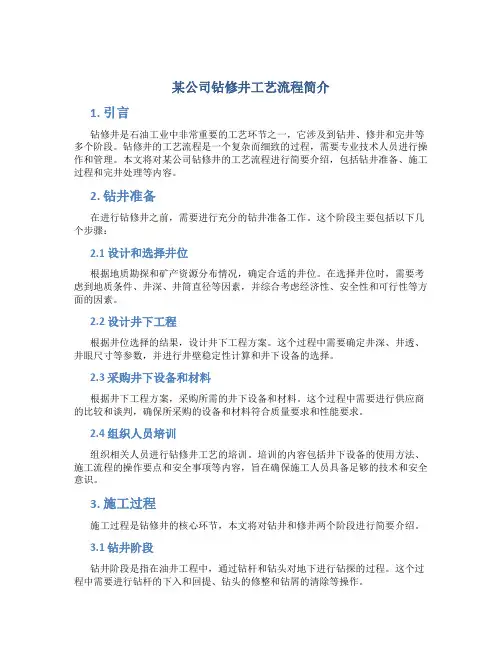
某公司钻修井工艺流程简介1. 引言钻修井是石油工业中非常重要的工艺环节之一,它涉及到钻井、修井和完井等多个阶段。
钻修井的工艺流程是一个复杂而细致的过程,需要专业技术人员进行操作和管理。
本文将对某公司钻修井的工艺流程进行简要介绍,包括钻井准备、施工过程和完井处理等内容。
2. 钻井准备在进行钻修井之前,需要进行充分的钻井准备工作。
这个阶段主要包括以下几个步骤:2.1 设计和选择井位根据地质勘探和矿产资源分布情况,确定合适的井位。
在选择井位时,需要考虑到地质条件、井深、井筒直径等因素,并综合考虑经济性、安全性和可行性等方面的因素。
2.2 设计井下工程根据井位选择的结果,设计井下工程方案。
这个过程中需要确定井深、井透、井眼尺寸等参数,并进行井壁稳定性计算和井下设备的选择。
2.3 采购井下设备和材料根据井下工程方案,采购所需的井下设备和材料。
这个过程中需要进行供应商的比较和谈判,确保所采购的设备和材料符合质量要求和性能要求。
2.4 组织人员培训组织相关人员进行钻修井工艺的培训。
培训的内容包括井下设备的使用方法、施工流程的操作要点和安全事项等内容,旨在确保施工人员具备足够的技术和安全意识。
3. 施工过程施工过程是钻修井的核心环节,本文将对钻井和修井两个阶段进行简要介绍。
3.1 钻井阶段钻井阶段是指在油井工程中,通过钻杆和钻头对地下进行钻探的过程。
这个过程中需要进行钻杆的下入和回提、钻头的修整和钻屑的清除等操作。
3.2 修井阶段修井阶段是指在钻井完成后,对井筒进行修整和完善的过程。
这个过程中需要进行井下设备的安装和测试、井眼的清理和整平等操作。
4. 完井处理完井处理是指在修井阶段完成后,对整个井筒进行处理和测试以确保井筒的完整性和稳定性。
这个阶段需要进行水泥浆的注入和固井、封井器的安装、产能测试和井口装置的安装等操作。
5. 总结某公司钻修井的工艺流程包括钻井准备、施工过程和完井处理三个阶段。
在每个阶段中,都需要严格遵循操作规程和安全标准,确保施工的质量和效率。
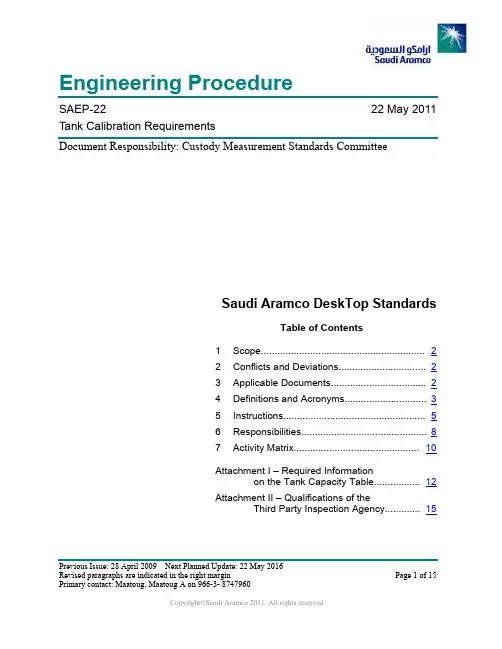
Previous Issue: 28 April 2009 Next Planned Update: 22 May 2016Revised paragraphs are indicated in the right marginPage 1 of 15Primary contact: Maatoug, Maatoug A on 966-3- 8747960Engineering ProcedureSAEP-2222 May 2011Tank Calibration RequirementsDocument Responsibility: Custody Measurement Standards CommitteeSaudi Aramco DeskTop StandardsTable of Contents1 Scope............................................................2 2 Conflicts and Deviations................................ 23 Applicable Documents................................... 24 Definitions and Acronyms.............................. 35 Instructions.................................................... 56 Responsibilities.............................................. 87 Activity Matrix.............................................. 10 Attachment I – Required Information on the Tank Capacity Table................. 12 Attachment II – Qualifications of theThird Party Inspection Agency (15)Next Planned Update: 22 May 2016 Tank Calibration Requirements 1 ScopeThis procedure establishes the instructions and responsibilities for the calibration ofall Saudi Aramco royalty/custody tank gauging applications. This procedure is alsoapplicable to the inventory tanks that have the potential to be used for custody orroyalty measurement applications in case of the metering system failures. Organizations for which responsibilities are specified include, but are not limited to:∙The Proponent Organization∙Saudi Aramco Project Management Team (SAPMT)∙Process & Control Systems Department (P&CSD)2 Conflicts and Deviations2.1 Any conflicts between this procedure and other applicable Saudi AramcoEngineering Standards (SAESs), Materials System Specifications (SAMSSs),Standard Drawings (SASDs), or industry standards, codes, and forms shall beresolved in writing by the Manager, Process & Control Systems Department ofSaudi Aramco, Dhahran.2.2 Direct all requests to deviate from this procedure in writing in accordance withSAEP-302 to the Manager, Process & Control Systems Department of SaudiAramco, Dhahran.2.3 Direct all requests for interpretation of this procedure in writing to the Chairman,Custody Measurement Standards Committee for resolution. The Chairman,Custody Measurement Standards Committee shall be solely responsible fordetermining whether a proposed request meets the requirements of this procedure.3 Applicable DocumentsThe procedures covered by this document shall comply with the latest edition of thereferences listed below, unless otherwise noted:3.1 Saudi Aramco ReferenceSaudi Aramco Engineering ProcedureSAEP-302Instructions for Obtaining a Waiver of aMandatory Saudi Aramco EngineeringRequirementNext Planned Update: 22 May 2016 Tank Calibration Requirements3.2 Industry Codes and StandardsAmerican Petroleum Institute (API) Manual of Petroleum MeasurementStandards (MPMS)Chapter 2.2A Measurement and Calibration of UprightCylindrical Tanks by the Manual StrappingMethodChapter 2.2B Calibration of Upright Cylindrical Tanks usingthe Optical-Reference Line MethodChapter 2.2C Calibration of Upright Cylindrical Tanks usingthe Optical-Triangulation MethodChapter 2.2D Calibration of Upright Cylindrical Tanks usingthe Internal Electro-optical Distance RangingMethodChapter 2.2E Calibration of Horizontal Cylindrical Tanks-Part 1: Manual MethodsChapter 2.2F Calibration of Horizontal Cylindrical Tanks-Part 2: Internal Electro-Optical Distance-Ranging MethodStandard 2552 Method for Measurement and Calibration ofSpheres and SpheroidsStandard 2555 Liquid Calibration of Tanks4 Definitions and Acronyms4.1 DefinitionsApprove: Review and formal acceptance characterized by the signature of thefinal authorizing individual or organization.Capacity Table: A table often referred to as a tank capacity table or calibrationtable, showing the capacities of or volumes in a tank for various liquid levelsmeasured from the reference gauge point.Critical Zone: The region between initial and complete flotation of a floatingroof.Custody Transfer Measurement: A specialized form of measurement thatprovides quantity and quality information used for the physical and fiscaldocumentation of a change in ownership and/or responsibility of hydrocarboncommodities. This includes measurement of hydrocarbon liquid movementsNext Planned Update: 22 May 2016 Tank Calibration Requirements(deliveries or receipts) between Saudi Aramco and its customers, suppliers, jointventures and transport contractors including VELA ships.Customer: The party that takes ownership or responsibility of a hydrocarboncommodity from Saudi Aramco.Datum plate: A level metal plate located directly under the reference gaugepoint to provide a fixed contact surface from which liquid depth measurementcan be made.Deadwood: Deadwood refers to any object within the tank, including a floatingroof, which displaces liquid and reduces the capacity of the tank; also anypermanent appurtenances on the outside of the tank, such as cleanout boxes ormanholes, which increase the capacity of the tank. Deadwood is positive if itincreases tank capacity or negative if it decreases capacity.External Floating Roof: A cover over an open top storage tank consisting of adeck which rests upon the liquid being contained.Internal Floating Roof: A cover within a fixed roof tank which rests upon thepetroleum liquid being contained.Master Tape: A tape that is used for calibrating working tapes for tankmeasurements and is identified with a report of calibration at 68°F (20°C) and aspecific tension designated by the National Institute of Standards andTechnology (NIST) or an equivalent international standard organization.Recomputation: The process of re-generating the capacity tables through softcalculations, without repeating the field calibration measurements. It involves,simply, updating or revising the capacity table using previously established tankdiametersReference Gauge Height: The distance from the datum plate or tank bottom tothe reference gauge point.Royalty Measurement: A specialized form of measurement that is used as thebasis for paying royalty to the Saudi Arabian Government.SAP: The Saudi Aramco main system for enterprise resource management.Spheres: A stationary liquid storage tank, supported on columns so that theentire tank shall be aboveground.Spheroid: A stationary liquid storage tank having a shell of double curvature.Any horizontal cross-section is a series of circular arcs.Next Planned Update: 22 May 2016 Tank Calibration Requirements Strapping: The measurement of the external circumference of a vertical orhorizontal cylindrical tank by stretching a steel tape around each course of thetank's plates and recording the measurement.Tank Calibration: The process of determining the capacity of a tank throughfield measurements.Third Party Inspection Agency: An independent inspection agency whosefunction is to conduct an unbiased inspection of certain systems, equipment,materials, etc., against a set of standards, guidelines or procedures. For purposesof this SAEP, the Third Party Inspector has particular knowledge of andexperience of conducting tank calibration in accordance with industry custodymeasurement standards and procedures.4.2 AbbreviationsAPI American Petroleum InstituteCMU Custody Measurement Unit of Process & Control SystemsDepartmentEODR Electro Optical Distance RangingORLM Optical Reference Line MethodMPMS Manual of Petroleum Measurement StandardsP&CSD Process & Control Systems DepartmentSA Saudi AramcoSAEP Saudi Aramco Engineering ProcedureSAES Saudi Aramco Engineering StandardSAMSS Saudi Aramco Material SpecificationSAP Systems Application ProgrammingSASD Saudi Aramco Engineering Standard Drawing5 Instructions5.1 GeneralThis procedure shall be used in conjunction with existing international standardsand is not intended to replace the standards referred to in Section 3 above.The reference temperature for all tank capacity tables shall be 60°F forRefineries, Terminals, Gas Plants and 15°C for Distribution Operations.Next Planned Update: 22 May 2016 Tank Calibration Requirements5.2 Calibration/Re-calibration FrequenciesAll new tanks/vessels used for custody transfer measurement must undergocalibration prior to being put in service.All tanks/vessels must be recalibrated in conjunction with Testing andInspection (T&I), or when a major repair is don for tank bottom.The upright cylindrical tank shall be recalibrated in accordance within volume detected to invoke this appendix requirement.5.3 Precalibration PreparationsPrior to calibration, the upright cylindrical tanks, horizontal tanks, spheres andspheroids must have been filled to 95% of their design operating capacity for aminimum period of 24 hours with a liquid at least as dense as the product theywill normally store.Commentary Note:This requirement is considered met if the tank/vessel has been already hydro-tested.5.4 Recomputation RequirementsThe capacity table of horizontal tanks, spheres and spheroids must berecomputed if variation in product operating temperatures and temperatureassumed during calibration is greater than 11°C (20°F).Commentary Note:Variations in the product's calibration specific gravity and operating specificgravity greater than 20% will require a recomputation of the table, due to thehydrostatic head effect expansion on tanks/vessels.Floating roof correction table requires recomputation when any variation in theroof's weight, due to repairs or modifications, results in a change in the roofdeadweight that altered the tank predetermined volume by 0.02% or more.Commentary Note:While recalibration involves reestablishing tank diameters through standardcalibration methods and developing new tank capacity tables for custody andnon-custody transfers, recomputation, involves simply updating or revising thecapacity table using previously established tank diameters.Next Planned Update: 22 May 2016 Tank Calibration Requirements5.5 Acceptable Calibration TechnologiesFollowing is a list of the calibration technologies acceptable for tank/vesselcalibrations along with the reference standard the methods' implementationshould comply to. The methods are arranged in the order of priority, based onthe most efficient means of calibration for a given set of conditions.(1) Internal Electro Optical Distance Ranging Method (EODR),API Chapter 2.2D(2) Internal Electro Optical Distance Ranging Method (EODR),API Chapter 2.2F(3) Optical Reference Line Method (ORLM), API Chapter 2.2B(4) Manual Strapping Method(Strapping), API Chapter 2.2A(5) Optical Triangulation Method, API Chapter 2.2C(6) Manual Methods, API Chapter 2.2E(7) Liquid Calibration, API 2555(8) Method for Measurement and Calibration of Spheres and Spheroids,API STD 2552Commentary Note:All these methods essentially provide alternate techniques for measuring tankdiameters. While manual strapping is limited to external calibrations, theremaining methods can be used either externally or internally.5.6 Technology Selection Guidelinesa. The application of the EODR shall be limited to tanks/vessels that aregreater than 5 meters in diameter.b. The application of liquid calibration shall be limited to tanks/vessels thatare smaller than 5 meters in diameter.c. If a tank/vessel is insulated, it should be calibrated internally.d. External and internal EODR shall be used for all tanks/vessels that aregreater than 5 meters in diameter with no insulation.e. Either Internal or external ORLM shall be used for floating roof tanks.f. External ORLM can be used for fixed roof tanks with no insulation andhaving not more than a single wind girder.g. If the tank has multiple external wind girders, it should be calibrated eitherby external/internal EODR or internal ORLM.Next Planned Update: 22 May 2016 Tank Calibration Requirementsh.bottom elevations shall be sighted along radii every 45 degrees. Alongthese radii, elevations should be obtained at equally spaced intervals notmore than 10 feet (3 meters) from the tank's center to its shell. Liquidcalibration method is permitted to be used whenever the tank containsirregular shaped deadwood (e.g., steam coils, etc.).i. Spheres and spheroids shall be calibrated in accordance with API STD2552, Method for Measurement and Calibration of Spheres and Spheroids.6 ResponsibilitiesThe Saudi Aramco organizations with tank/vessels calibration responsibilities shallensure that their personnel become familiar with this SAEP.6.1 Saudi Aramco Project Management Team (SAPMT)a. Initiate calibration request for new tanks/vessels,b. Inform CMU of the calibration of new tanks only if is used for royaltytransfer,c. Request list of Approved Third Party Inspection Agencies,d. Contract tank calibrations to an approved Third Party Inspection Agency,e. Inform the Proponent to witness the calibration process,f. Obtain the capacity tables from the Third Party Inspection Agency,g. Request CMU's review for capacity tables of new royalty tanks,h. Provide two hardcopy and two electronic tables in US Customary unitsand/or (based on application requirement) SI units of the final approvedcalibration calculation and the capacity table to the Proponent.i. Close the activity.6.2 The Proponent Organizationa. Initiate requests for in-service tanks/vessels per the frequencyrequirements set forth in Section 5.2 above,b. Inform CMU of the calibration of new tanks if it is used for royaltytransfer applications,c. Request list of the approved Third Party Inspection Agencies,d. Contract tank calibrations to an approved Third Party Inspection Agency,e. Provide the operating data (operating temperature, density at operatingtemperature, operating pressure) to the Third Party Inspection Agency,Next Planned Update: 22 May 2016 Tank Calibration Requirementsf. Ensure the equipment used has been calibrated and has valid certificatesthat are traceable to National Institute of Standard and Technology (NIST)or other approved standards organization,g. Witness the field calibration process and ensure that the Third PartyInspection Agency is performing the tank/vessel calibration calculations inaccordance API MPMS Chapter 2.2A and API STD 2552, including, butnot limited to, the following capacity table correction factors,i. master tape corrections.ii. working tape correction.iii. tape rise correction.iv. tank shell temperature expansion correction.v. hydrostatic head effect correction.vi. tilt correction.vii. floating roof gravity adjustment.h. Consult with CMU if a technical inquiry about the calibration and/ordocumentation process cannot be resolved internally,i. Review the draft calibration calculations,j. Review the produced capacity tables and make sure they comply with the requirements in Attachment I,k. Submit the capacity tables for the calibration of the new tanks to theSAPMT,l. Submit initial capacity tables of new royalty tanks only to CMU forreview.m. Maintain two hardcopy and two electronic tables in US Customary units and/or (based on application requirement) SI units of the final approvedcalibration calculation and the capacity table to the proponent,n. Update the SAP Tank Gauging System with the new approved capacitytable, if applicable,o. Inform the SAPMT of the completion of the tank calibration,p. Commission the tank,q. Close the activity.6.3 Process & Control Systems Department (P&CSD)The Process & Control Systems Department/Custody Measurement Unit (CMU)is responsible for providing technical assistance to the Proponent(s) on mattersNext Planned Update: 22 May 2016 Tank Calibration Requirements pertaining to tank calibrations. Specific responsibilities of CMU aresummarized below:a. Review the qualifications of the Third Party Inspection Agencies and makesure they meet all of the requirements detailed in Attachment II.b. Maintain the list of Approved Third Party Inspection Agencies.c. Submit the list of the Approved Third Party Inspection Agencies to theSAPMT and the Proponent upon request.d. Upon request from the proponent, provide consultation if a technicalinquiry about the calibration and/or documentation process cannot beresolved internally.e. Review initial capacity tables of new royalty tanks only.7 Activity MatrixThe following matrix summarizes the general sequence of activities and corresponding responsible organizations for calibrating tanks. Detailed requirements for eachorganization are specified in Section 6.Next Planned Update: 22 May 2016 Tank Calibration RequirementsNote:(1) SAPMT initiates calibration request for new tanks/vessels. The Proponent initiates calibrationrequest for tanks/vessels in-service per the frequency requirements set forth in Section 5 above.For BI-1900, the proponent will assume the responsibilities of SAPMT.Revision Summary22 May 2011 Revised the "Next Planned Update". Reaffirmed the contents of the document, and reissuedwith minor changes.Next Planned Update: 22 May 2016 Tank Calibration Requirements Attachment I – Required Information on the Tank Capacity TableThe final capacity table should contain the following minimum documentation details:1. Tank Identificationa. The site or installation tank numberb. Location Titled with “Saudi Arabian Oil Company”c. The type of tank in serviced. The name of the plant, owner or operatore. The name and address of the calibration authority or company which carriedout the calibration.2. Product InformationThe product name and density of the liquid stored in the tank when in service andused in the computation of the tank capacity tables.3. Operational Detailsa. The standard temperature (60°F for U.S. Customary, or 15°C for metrictables) for which the tank capacity table has been calculated.b. Operating temperature and pressurec. Table type (innage or ullage)4. Traceability and Tracking Detailsa. The date a new tank was first calibratedb. The date an old tank was recalibratedc. Calibration agent reference document numberd. The date the tank was recomputed, and the method used for recomputatione. The date of the calibration along with specific references to the methodadopted in calibrating the tank bottomf. Page numberg. Reference to the standard on which the calibration is basedh. The Third Party Inspection Agency shall sign and stamp each page of thecertificate.Next Planned Update: 22 May 2016 Tank Calibration Requirements5. Tank Dimensionsa. The nominal height and diameter of the tankb. Description of the tank bottom type, along with the method used todetermine the bottom volumec. Integrated deadwood, accurately accounted for as to location and volume,and included as an attachmentd. Note on capacity table that the volume below the striking plate is included inthe first measuremente. The shell height, is measured as the vertical distance between the bottom ofthe bottom angle and top of the top angle and measured near the referencegauge hatchf. Reference height measurement point locations shall be clearly identified ontank capacity tablesg. The height of the datum-points(s) with reference to the junction of the tankshell and bottom platingh. If an automatic gauging system is installed, the height of the gauge datumpoint with reference to the junction of the tank shell and bottom platingi. Maximum fill heightj. Safe fill height specified by the tank ownerk. The amount of tilt in shell height is measured and recorded.l. Height of the striking point (datum plate) from the tank bottom platem. The decimal (fraction) average volume for each strapping page.6. Floating Roof Informationa. The allowance for the roof is to be treated as deadwood and incorporated inthe tank capacity table directly, not as a separate attachmentb. The density of the liquid for which the roof has been calculated shall berecorded on the table directlyc. The apparent mass in air of the roof and accessoriesd. The displacement volume of the roof and the floating roof correction factormethod statemente. A defined level (Level A), with the distance above the dip point designatingwhere the roof is at restf. A defined level (Level B), with the distance when the roof is just fullyfloating in the lowest-density liquid to be contained in the tankNext Planned Update: 22 May 2016 Tank Calibration Requirementsg. The part of the capacity table between Level A and Level B is marked as“Not Accurate”h. Critical zones shall be identified within the tablei. The range where floating roof adjustment not to be performed.7. Tank Shell Correctiona. A shell temperature expansion factor table is to be developed in incrementsof 5°F or 3°C and included as an attachment to the capacity table for aspecific operating range.b. Include the equation for determining the shell temperature.Next Planned Update: 22 May 2016 Tank Calibration Requirements Attachment II – Qualifications of the Third Party Inspection AgencyThe Third Party Inspection Agency shall meet all of the following requirements:1. The agency has provided similar services for a minimum of 3 years. It shallsubmit a list of companies for which it has provided similar calibration servicesover the preceding 3 years.2. The agency's personnel performing the field measurements and calculations musthave a minimum of one year experience with the application of the APItank/vessel calibration standards. Experience shall be documented by submittal ofresume and verifiable work histories.3. The agency shall have written procedures which meet the requirements of APItank/vessel calibration standards. It shall submit the written procedures forreview.4. The agency shall have equipment as specified in API MPMS Chapter 2.2. It shallsubmit a list of the equipment it intends to use along with corresponding validcalibration certificates.5. The agency shall demonstrate it is ISO-certified and that it is activelyadministering a quality assurance program. It shall submit a copy of its ISOcertification and his quality assurance program details for review.6. The agency shall demonstrate that it is capable of performing the tank/vesselcalibration calculations. It shall provide a minimum of two samples of previouscalibration results, including field data and all calculations.7. The agency shall provide financial and insurance documentations as deemednecessary by the Contracting Unit to ensure he has adequate liability coverage fordamages done to Saudi Aramco facilities.。
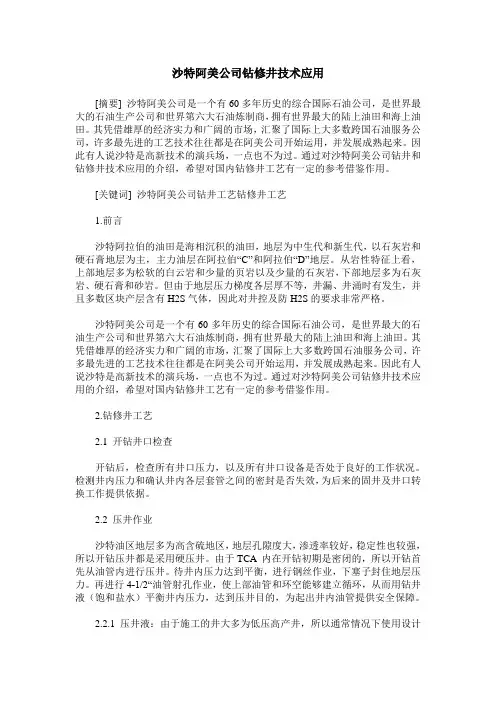
沙特阿美公司钻修井技术应用[摘要] 沙特阿美公司是一个有60多年历史的综合国际石油公司,是世界最大的石油生产公司和世界第六大石油炼制商,拥有世界最大的陆上油田和海上油田。
其凭借雄厚的经济实力和广阔的市场,汇聚了国际上大多数跨国石油服务公司,许多最先进的工艺技术往往都是在阿美公司开始运用,并发展成熟起来。
因此有人说沙特是高新技术的演兵场,一点也不为过。
通过对沙特阿美公司钻井和钻修井技术应用的介绍,希望对国内钻修井工艺有一定的参考借鉴作用。
[关键词] 沙特阿美公司钻井工艺钻修井工艺1.前言沙特阿拉伯的油田是海相沉积的油田,地层为中生代和新生代,以石灰岩和硬石膏地层为主,主力油层在阿拉伯“C”和阿拉伯“D”地层。
从岩性特征上看,上部地层多为松软的白云岩和少量的页岩以及少量的石灰岩,下部地层多为石灰岩、硬石膏和砂岩。
但由于地层压力梯度各层厚不等,井漏、井涌时有发生,并且多数区块产层含有H2S气体,因此对井控及防H2S的要求非常严格。
沙特阿美公司是一个有60多年历史的综合国际石油公司,是世界最大的石油生产公司和世界第六大石油炼制商,拥有世界最大的陆上油田和海上油田。
其凭借雄厚的经济实力和广阔的市场,汇聚了国际上大多数跨国石油服务公司,许多最先进的工艺技术往往都是在阿美公司开始运用,并发展成熟起来。
因此有人说沙特是高新技术的演兵场,一点也不为过。
通过对沙特阿美公司钻修井技术应用的介绍,希望对国内钻修井工艺有一定的参考借鉴作用。
2.钻修井工艺2.1 开钻井口检查开钻后,检查所有井口压力,以及所有井口设备是否处于良好的工作状况。
检测井内压力和确认井内各层套管之间的密封是否失效,为后来的固井及井口转换工作提供依据。
2.2 压井作业沙特油区地层多为高含硫地区,地层孔隙度大,渗透率较好,稳定性也较强,所以开钻压井都是采用硬压井。
由于TCA 内在开钻初期是密闭的,所以开钻首先从油管内进行压井。
待井内压力达到平衡,进行钢丝作业,下塞子封住地层压力。

浅谈沙特阿美非常规钻机的设备验收摘要沙特阿美石油公司以其严格的安全标准闻名于世。
沙特阿美石油公司非常规钻井部起源于探井钻井部,是对安全要求最为苛刻的部门。
本文将以SPXXX队新钻机验收检查为例,浅谈沙特阿美非常规钻机的设备验收。
关键词:安全;标准;非常规;验收沙特阿美石油公司新钻机验收生产(设备)部分以及安全部分以检查单的形式进行。
在检查过程中,除执行沙特阿美石油公司的通用标准之外,非常规钻井部的验收将更加苛刻,其对于相关标准的解读和执行也更加严格和深入。
本文将主要就新钻机验收检查中钻井队因为前期设备建造过程中疏忽而造成的问题进行总结,以期在今后的新钻机建造验收过程中能够节约人力物力,尽早通过验收。
新钻机验收安全部分主要由沙特阿美石油公司DOE&CD(钻修井作业合规部)派往现场的安全官完成。
该部分检查的主要依据来自于沙特阿美石油公司钻修井部的HSERM(健康、安全、环境要求手册)和SWIM(安全作业指导手册)。
因此,为顺利通过新钻机开钻验收,熟读这两本手册非常有必要,当安全官提出不合理的要求时,可以依据这两本手册的内容对其不合理要求进行反驳。
下文将对新钻机验收安全按照类别分别进行说明。
1 设备合格证及相关文档资料设备合格证,即COC(certificate of compliance),符合性证明,是对符合标准要求的产品颁发的证书,可以简单理解成设备合格证。
设备合格证标明设备的序列号、制造日期等关键内容,是验证设备可追溯性的重要证据。
无论是在非常规钻井部的开钻验收检查还是在开钻以后的设备三类、四类检测中,设备合格证都是必须提供的证书。
设备合格证不仅仅需要收集各种主体设备如井架、底座、钻机、泥浆泵、天车、游车、顶驱等的合格证,还需要收集如泄压阀(PRV)、气罐、天车游车滑轮、起升滑轮等的合格证及相关支撑文档。
尤其是泄压阀,遍布设备的各个角落,如泥浆泵、灌注泵、气瓶、空气压缩机、各个液压站等处。
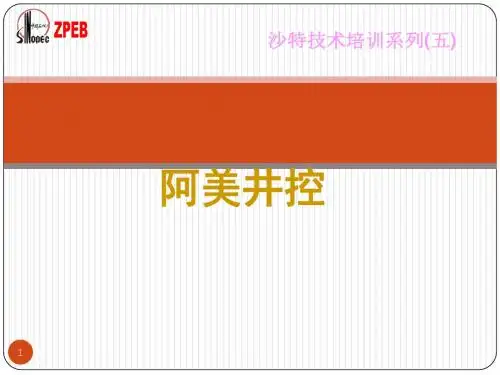
沙特阿拉伯NYYM—133三底水平井钻井技术摘要:NYYM-133井位于沙特NYYM区块,是一口140度扇形内的三底水平井,主要是探明NYYM地区油气产量。
介绍了三底水平井井身结构、钻具组合、钻井液性能、开窗方法及施工工艺;直井段优选大功率螺杆塔式钻具结构,解决了直井段防斜,分支井段采用SMITH WHIPSTOCK套管开窗技术,实现定向、开窗、修窗一次完成,水平井段采用SPERRY-SUN公司旋转导向技术;优选油基钻井液,采取低粘、高粘交替循环清洗井底,及防卡、降摩等措施,安全快速地完成了施工,对国内外同类井的施工提供了借鉴。
关键词:钻井;技术;三底井;多底水平井;开窗;分支;全油基钻井液;防卡工艺;增斜稳斜;NYYM-133井;沙特阿拉伯1 前言NYYM-133井位于沙特阿拉伯国家NYYM区块,设计开发UNAIZA-A-RESERVOIR油层,产层连通油层达6000英尺,主要目的是探明NYYM地区产层产油气量,为下一步油气开发积累宝贵经验和地质资料;为了提高单井油气产收率和单井控制油气储量,阿美公司在NYYM区块部署的是一口140度扇形内的三井底水平井,提高水平段的泄油通道,达到增加产量的目的。
扇形水平井形成的油气通道,可提高单位面积内的气液两相流的导流能力,大幅提高井眼与油气的泄油面积,降低油气田的投资费用。
2 多底水平井技术难点3 现场施工主要技术3.1直井段防斜技术从一开到早斜点的直井段,均采用的是典型的塔式钻具结构:钻头+近钻头扶正器+ 减震器+9?”DC x1根+钻柱形扶正器+9?” DC x 2根+,8?”DC x8根+5” HWDP x 15根+5” DP.。
为了保证钻进更加安全,采用磙子扶正器和减震器来降低井下扭矩和震动,并起到了修整井壁的作用。
钻井液为搬土和石灰,比重63pcf (0.99 g/cm3,),并配足够用高粘,用于洗井和封底。
在进人WASIA地层之前确保有足够容量的75pcf泥浆帽。